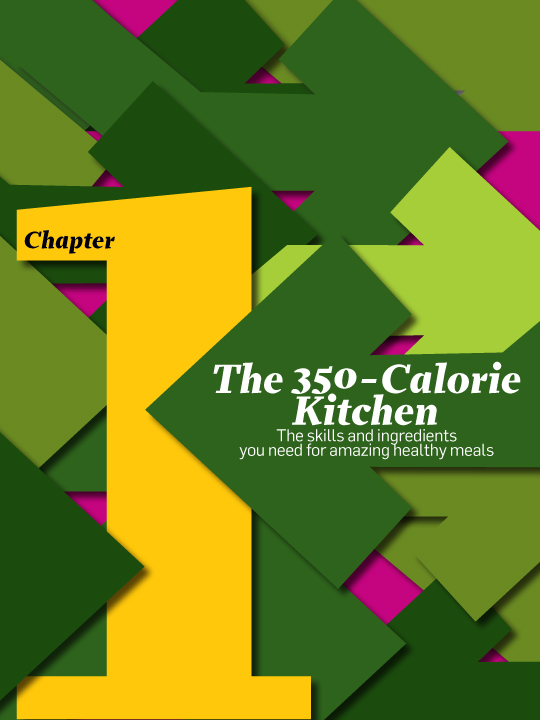


At least, it shouldn’t be. And yet, for so many people, the idea of coming home from a long day of work only to have to fire up the stovetop and find a way to put dinner on the table is only slightly more tolerable than, say, pulling weeds or changing the oil in your car. The main goal of this book isn’t to make you skinnier and healthier; it’s to make you a better, more enthusiastic cook. Once we do that, those other two admirable goals will fall into place easily enough.
We sincerely hope the abundance of delicious recipes—and the mouthwatering photos that accompany them—found within this book will provide plenty of inspiration and motivation for your time in the kitchen. But more than just concrete recipes intended for repetition, we hope that the mixture of simple cooking lessons and ingredient spotlights will help you build a set of skills and a well-stocked pantry that can be tapped into at any given moment to create magical meals in an instant. It’s precisely at that moment, when you can put away the recipe and create something uniquely your own, that cooking ceases to be a chore and starts to become a lifelong passion.
Teach a man to fish, feed him for a day. Teach him to fillet that fish, pan-sear it, and serve it with a scoop of mango salsa, and you’ll feed him for a lifetime. Combine these essential techniques with fresh ingredients and you’ll eat well for the rest of your years.
STEP-BY-STEP • BROILING
The broiler is the most underused appliance in the kitchen. Those blazing coils in your oven are nothing more than an inverted grill, capable of delivering big blasts of heat—and deep, flavorful caramelization to your food in a short period of time.
BEST FOR: Burgers, steaks, fish fillets, chicken breasts

Step 1: Preheat the broiler and allow it to warm up for at least 5 minutes before cooking. Line a broiling pan or baking dish with foil (because of the high heat, cleanup can be a mess without the foil) and place the meat on top. Situate the pan or dish 6 inches below the heat source. This is close enough to help brown the food, but not so close it will char it before it's done cooking through.
Step 2: Since the heat is only coming from one direction, You’ll need to flip the meat or fish at the halfway cooking point. Burgers and steaks will take about 10 minutes to cook to medium rare underneath the broiler; a fish fillet of medium thickness should be done in 7 to 8 minutes. Beyond cooking protein, the broiler is perfect for melting cheese, toasting a sandwich, and putting a crust on baked pasta dishes.
STEP-BY-STEP • SAUTÉING
Sautéing simply means cooking in a pan with butter or oil. Done slowly over low heat, sauteing cooks the excess water out of vegetables, concentrating their natural sugars and innate flavor. Done quickly over moderare to high heat, sauteing produce nicely browned exteriors on everything from mushroom and zucchini slices to shrimp and chunks of chicken.
BEST FOR: Delicate fish, shellfish, nearly all vegetables

Step 1: Preheat a pan or skillet with enough butter or oil to coat. Vary the heat depending on what you're going for: low heat for slowly caramelizing onions and cooking down tomatoes; high heat for browning mushrooms, peppers, and other vegetables. If you're doing the latter, don't crowd the pan. Too much food will make it impossible for the ingredients to properly brown.
Step 2: Stir as often as possible so that all sides of the food cook evenly. Season, but be mindful of when you do so: Salt draws out water, so if you add it early, the moisture will cause your food to steam in its own juices. For caramelizing onions, this is a good thing; for browning mushrooms, not so much. Thin fish fillets like sole and tilapia can also be sauteed, but this should be done in a nonstick pan.
STEP-BY-STEP • BRAISING
Braising is the technique responsible for the most tender meats and the most complex flavors. It’s also the most effective way to stretch a dollar in the kitchen, as braising is all about turning tough, inexpensive cuts of meat into intensely flavored, deeply satisfying meals. After taking 10 minutes to put the dish into motion, braising requires little or no effort from you.
BEST FOR: Tough cuts of meat like chuck roast, short ribs, shanks, chicken legs

Step 1: Heat a stainless steel pot or pan over medium-high heat and coat with enough oil to cover. Season meat with salt and pepper and add it to the pan. The goal is a deeply browned exterior, which will in turn flavor the braising liquid. Warning: If you crowd the pan, the surface temp will plummet and the food will not brown properly.
Step 2: Once the meat has been fully browned, it's time to deglaze. Add wine or stock or a combination of both. As it simmers, use a wooden spoon to scrape up any bits stuck to the bottom of the pan. These little bits constitute the flavor that will ultimately infuse the entire braise, so be sure to work them off the pan.
Step 3: If braising on the stovetop or in the oven, return the meat to the pan, along with a mix of chopped onions, carrots, celery, and garlic. If you prefer a slow cooker, line the bottom with the meat, top with the vegetables, then pour the deglazing liquid over it all. Cook over low heat until the meat is fork-tender.
STEP-BY-STEP • PAN-SEAR
Like sautéing on steroids, pan-searing concentrates the natural flavors in fish and meat. The high-heat technique is best for when you want to create a crust on your food, a caramelized layer that is not just big on flavor, but also provides important textural contrast to the soft meat within.
BEST FOR: Thick fish filets, steak, chicken (especially with the skin on)

Step 1: Heat a bit of oil in a pan over high heat. Because it requires such intense heat, pan-searing should be done in a cast-iron skillet or in a stainless steelx pan. (High heat will eat away at the Teflon on nonstick pans.) When wisps of smoke rise from the pan, season the meat or fish and place in the pan.
Step 2: Allow the meat or fish to cook, undisturbed, until a dark crust has formed on the surface, at least 3 minutes. Flip.
Step 3: Place the pan in a preheated 400˚F oven to finish cooking. If you try to finish on the stovetop, you're likely to burn the outside of the food before cooking it all the way through. The consistent, enveloping heat of the oven allows for even cooking, so your food will be uniformly cooked all the way through.
STEP-BY-STEP • KNIFE SKILLS
More than any other technique, sound knife skills will help you cook more quickly and efficiently. Not only that, there’s something unbelievably thrilling about being to work your way through a pile of vegetables like a world-class chef.
The best piece of food you can learn to cut is an onion. That’s because the same basic technique that goes into chopping, dicing, or mincing an onion can be applied to nearly any fruit or vegetable you’ll find on your cutting board. See how it works in the first sequence.

Step 1: Holding the knife parallel to the cutting board, make horizontal cuts through the onion, stopping just short of cutting all the way through.
Step 2: Use the tip of the blade to make vertical cuts, again being careful not to cut through the back of the onion (keeping it intact holds the onion together).
Step 3: Tucking your fingertips in to protect them from the blade, slowly work your free hand toward the back of the onion, with the knife chopping closely in its wake. The more horizontal and vertical cuts you've made, the finer the cut.
The other critical knife technique is the rock, which gives you full control of the blade as you slice, dice, and mince your way through anything and everything. The far-right sequence lays the move out in full.

Step 1: Plant the tip of the blade on the cutting board. Tuck the fingers of your free hand in and use it to stabilize the vegetable.
Step 2: Bring the knife down in a steady motion. The heel of the blade should just come off the board.
Step 3: Pull the knife immediately back up, creating a seemless rocking motion. Repeat, using your free hand to guide the blade as you cut your way across the vegetable.

We keep calories in check throughout this book by emphasizing lean protein and fresh fruits and vegetables over fat, sugar, and salt; by keeping portion sizes substantial but not elephantine; and by making smart substitutions that lighten a dish without compromising the taste or texture. But there are also a few basic techniques that you should add to your arsenal that will help eliminate some of the biggest caloric pitfalls of restaurant cooking. Learn the basics behind these five calorie-slashing skills and you’ll be ready to add layers of flavor to your food without adding layers of fat to your body.
1. Béchamel
When making an Alfredo sauce or mac and cheese—dishes that traditionally rely on heavy cream as their base—this mixture of milk and butter, thickened with a bit of flour, could save you 300 or 400 calories per serving. Béchamel is also the basis of traditional Italian lasagna and can be turned into a cheese sauce that can stretch a handful of cheese into a rich topping for nachos or baked potatoes. Here’s how you make it:
Step 1: Holding the knife parallel to the cutting board, make horizontal cuts through the onion, stopping just short of cutting all the way through.
Step 2: Slowly add milk, a few tablespoons at a time, whisking constantly to help keep the flour from forming lumps in the liquid.
Step 3: Season and simmer. Add salt and pepper to taste, plus any other flavors you like. Ground nutmeg, half an onion, or a few cloves of garlic (the latter of which should both be removed at the end) all boost the béchamel flavor.
2. Fresh Salsa
You’d be hard-pressed to find a healthier, more flavorful condiment than fresh-chopped salsa, especially when you experiment with different vegetables and fruit. The blueprint for every bowl of salsa is the same, so all you need to do is understand the basic three-step principle and you’ll be ready to salsa your way through the produce aisle.
Step 1: Choose a base. Tomatoes are traditional, of course, but a variety of fruits and vegetables work perfectly here: mangoes, pineapple, papaya, corn, even black beans.
Step 2: Add the supporting cast. Chopped red onion, chopped fresh cilantro, and minced jalapeño are the standard and they work equally well for fruit- and vegetable-based salsas. Other options include chopped bell pepper, scallions, and finely minced garlic.
Step 3: Add acid. Usually that means the juice of a lemon or a lime, but a splash of red wine or apple cider vinegar will have a similar flavor-enhancing effect.
3. Pan Sauces
Why bother with fussy, high-calorie sauces and condiments when the best possible accompaniment to your steak or chicken breast is clinging to the bottom of the pan you just cooked it in? All you need is a bit of liquid to extract that flavor from the surface of the pan and you’ll have a bold, beautiful sauce ready in a matter of minutes. (This same technique works in conjuction with pan-searing.)

Step 1: Cook meat or fish in a stainless steel sauté pan or cast-iron skillet. Remove and return the pan on the flame.
Step 2: Add minced shallots or red onions and a ½ cup of either red (for beef, lamb, and duck) or white (for chicken, fish, and pork) wine and a ½ cup of chicken stock. Use a wooden spoon to scrape up any browned bits that cling to the bottom of the pan. Add any other flavoring elements now; Dijon mustard, chopped rosemary, capers, and balsamic vinegar are all welcome additions.
Step 3: Boil vigorously until the liquid has reduced by 75 percent, about 5 minutes. Season with salt and pepper and remove from heat. At the last moment, swirl in a pat of butter. Besides adding richness, it also gives the sauce a velvety texture.
Step 4: Pour the sauce over the meat or fish and dig in.
4. Spice Rubs
Sometimes the only thing to make a piece of meat or fish an exciting prospect on your plate rather than a boring afterthought is a simple but smart sheath of spices. Rather than bog down your food with excess calories, they infuse a dish with a variety of powerful antioxidants—potent micronutrients known to fight cancer, reduce inflammation, and even speed up metabolism, among other marvelous side effects. The best rubs blend a spectrum of flavors into one seamless powder you can use to coat your favorite proteins. The whole idea is to tweak and refine your own blends, based on personal preferences, but as a general rule, it’s best to incorporate one member of at least three of these groups below into your magical meat dust.

HERE ARE SOME OF OUR FAVORITE BLENDS:
• FOR BEEF: Salt and pepper, garlic salt, cayenne, cumin, pinch of cinnamon
• FOR CHICKEN: Salt and pepper, cumin, chili powder, brown sugar
• FOR FISH: Salt and pepper, smoked paprika, thyme
5. Oven Frying
Not only is deep-frying the quickest way to shackle your food with excess calories, it’s also expensive, inconvenient, and potentially dangerous to have a vat of bubbling oil in a home kitchen. With the right oven temperature and technique, oven frying gives you the outside crunch and interior juiciness that we crave in fried foods without the hassle and the empty calories. Here’s how you do it:
Step 1: Make sure your meat, fish, or vegetables are all similar in size and shape (that way they cook evenly in the same amount of time). Set up three separate dips: a plate with flour, a bowl of beaten eggs, and a plate of breadcrumbs.
Step 2: Dip the meat, fish, or vegetables first in the flour, then into the egg (the flour helps the egg adhere to the food). From the egg, dip them into the bread crumbs, tossing so that each piece is thoroughly covered. Note: It’s best to keep one hand free for dry ingredients and the other for wet ones, otherwise things get messy.
Step 3: Place in a preheated oven. For larger pieces of meat such as whole chicken breasts, you’ll want a lower temperature (350 to 375°F) to ensure the bread crumbs don’t burn before the meat is cooked. For smaller pieces, a high temp (400 to 425°F) will help brown the bread crumbs into a crunchy crust before the meat or fish is overcooked. Chicken breasts will take about 15 minutes to cook through, fish fillets about 10 to 12.

Every good meal starts with a properly stocked pantry and fridge. To ensure you have the best building blocks possible, we’ve taken years’ worth of supermarket reconnaissance and distilled it down to our 50 favorite products in the aisles. Whether you’re looking for the healthiest sliced cheese for sandwiches, the best flour for pancakes and baked goods, or the leanest, tastiest frozen pizza for the nights you want to stay out of the kitchen, this is the last grocery list you’ll ever need to make.

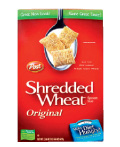
1 BEST CEREAL
Post Spoon-Size Shredded Wheat
This box contains no added sugars, oils, or artificial colors. Inside is nothing but pure, unadulterated whole wheat. Liven it up with fresh blueberries. Per cup: 170 calories, 1 g fat, 40 g carbs, 6 g fiber

2 BEST ENGLISH MUFFIN
Thomas’ Light Multi-Grain English Muffin
You won’t find a lighter English muffin. Nor will you find one with more fiber. Per muffin: 100 calories, 1.5 g fat, 24 g carbs, 8 g fiber

3 BEST BREAD
Martin’s Whole Wheat Potato Bread
Potato bread crowns a sandwich with a light touch of sweetness, and the heft of fiber in Martin’s Whole Wheat makes it a guilt-free upgrade. Per slice: 70 calories, 1 g fat, 14 g carbs, 4 g fiber
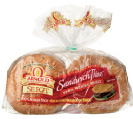
4 BEST BURGER BUN
Arnold Select 100% Whole Wheat Sandwich Thins
Bulging buns don’t hold burgers any better, but they do saddle you with loads of superfluous calories. Per roll: 100 calories, 1 g fat, 21 g carbs, 5 g fiber
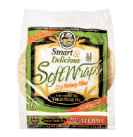
5 BEST TORTILLA
La Tortilla Factory Smart & Delicious EVOO MultiGrain
La Tortilla Factory’s wrap employs an arsenal of nutritional powerhouses such as sunflower seeds, oat fiber, and flax seed. Per wrap: 100 calories, 3.5 g fat (0.5 g saturated), 18 g carbs, 12 g fiber
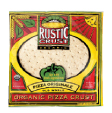
6 BEST PIZZA CRUST
Rustic Crust Organic Pizza Originale
No pizza is as healthy—or flavorful—as the one that sits atop a crust of basil and garlic-infused whole wheat. You won’t find a pizza base with fewer calories. Per 2-oz serving (about 1/6 of pie): 120 calories, 1.5 g fat , 25 g carbs, 1 g fiber

7 BEST PASTA
Ronzoni Healthy Harvest Whole Wheat Thin Spaghetti
Ronzoni manages to pack in all the fiber without the gritty texture of some of its whole-wheat competitors. Per 2 oz (uncooked): 180 calories, 2 g fat, 41 g carbs, 6 g fiber
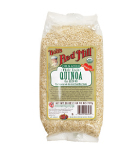
8 BEST GRAIN
Bob’s Red Mill Organic Whole Grain Quinoa
Quinoa packs in about twice as much protein as the typical cereal grain, and it contains all the essential amino acids your body needs to function at its peak. Per ¼ cup (uncooked): 170 calories, 30 g carbs, 3 g fiber, 2.5 g fat

9 BEST FLOUR
King Arthur Traditional 100% Whole Wheat
The hard red wheat used to produce this flour provides bolsters your diet with vitamin E and manganese, among other vital nutrients. Per ¼ cup: 110 calories, 0.5 g fat, 21 g carbs, 4 g fiber


10 BEST MILK
Organic Valley Reduced Fat 2%
Thanks to new USDA regulations, cows used for organic milk are now guaranteed to spend at least a few months of every year grazing on natural pasture grasses. Per cup: 130 calories, 5 g fat, 8 g protein

11 BEST SLICED CHEESE
Sargento Reduced Fat Swiss
Saving calories isn’t the only boon: The other payoff is more protein in each slice. Per slice: 60 calories, 4 g fat, 5 g protein
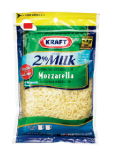
12 BEST SHREDDED CHEESE
Kraft Natural 2% Milk Mozzarella
The mild flavor and of mozzarella makes it the best utility player in the dairy cooler. Plus, no cheese comes with a lighter caloric toll. Per oz: 70 calories, 4 g fat, 8 g protein

13 BEST CREAM CHEESE
Philadelphia Whipped
The whipping process introduces air to the cream, which reduces the calories per serving and makes it easier to spread. Per 2 Tbsp: 60 calories, 6 g fat

14 BEST BUTTER
Organic Valley Sweet Cream Cultured Unsalted Butter
Don’t be afraid of real butter. Research shows that the fat in a pat of butter helps you better absorb vitamins A, E, and K. Per Tbsp: 100 calories, 11 g fat

15 BEST YOGURT
Fage Total 2% Greek Yogurt (7 oz container)
More than twice as much protein as standard American-style yogurt. Plus, the thicker consistency of Greek yogurt makes a prime base for sauces and marinades. Per container: 130 calories, 4.5 g fat, 15 g protein

16 BEST EGGS
Eggland’s Best
Each egg contains 115 milligrams of heart-healthy omega-3 fatty acids. Per large egg: 70 calories, 4 g fat, 6 g protein

17 BEST COLD CUT
Hormel Natural Choice Pre-Sliced Turkey and Ham
Packaged without nitrates or nitrites, Natural Choice makes some of the freshest-tasting deli meats ever to come out of a package. Per 4 slices Oven Roasted Deli turkey: 50 calories, 1 g fat, 10 g protein
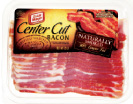
18 BEST BACON
Oscar Mayer Center Cut Naturally Smoked
When it comes to nationally available strips, these are tough to beat. Center cut bacon has a higher meat-to-fat ratio, making it less calorie dense. Per 3 slices: 60 calories, 4 g fat, 6 g protein
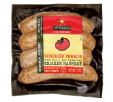
19 BEST SAUSAGE
Al Fresco Sundried Tomato & Basil Chicken Sausage
Al Fresco’s chicken sausages pack big flavor into a low-calorie package. Per link: 140 calories, 7 g fat, 15 g protein

20 BEST HOT DOG
Applegate Farms Uncured Beef Hot Dogs
They’re low in calories, sure, but they also taste like real beef—a huge improvement over the bologna-like dogs from Ball Park and Oscar Mayer. Per dog: 70 calories, 4.5 g fat, 6 g protein

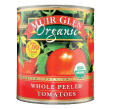
21 BEST CANNED TOMATOES
Muir Glen Organic Whole Peeled Tomatoes
8 hours of harvest, giving them a far fresher flavor than the pallid out-of-season supermarket tomato. Per ½ cup: 25 calories, 1 g fiber, 5 g carbs
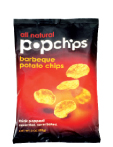
22 BEST POTATO CHIP
Popchips All Natural Barbecue
The heat-compression technique developed by Popchips gives these spuds more flavor than a baked chip with fewer calories than a fried chip. Per oz: 120 calories, 4 g fat, 20 g carbs, 1 g fiber
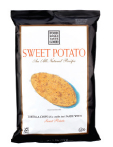
23 BEST TORTILLA CHIP
Food Should Taste Good Sweet Potato Tortilla Chips
They deliver more flavor than a typical tortilla chip, and each serving meets 20% of your day’s vitamin A requirement. Per oz: 140 calories, 6 g fat, 18 g carbs, 3 g fiber

24 BEST CRACKER
Triscuit Original
Perfect foods come in simple packages, and Triscuits are as simple as crackers can be. Per 6 crackers: 120 calories, 4.5 g fat, 19 g carbs, 3 g fiber

25 BEST NUTS
Emerald Cocoa Roast Almonds, Dark Chocolate
This snack tastes like candy, but instead of bombarding you with sugar, it offers up a hearty dose of heart-healthy fats. Per ¼ cup: 150 calories, 13 g fat, 6 g carbs, 3 g fiber

26 BEST SNACK BAR
Lärabar Pecan Pie
The only ingredients in this delicious snack bar are dates, pecans, and almonds. If only real pecan pie were so honest. Per bar: 220 calories, 14 g fat, 24 g carbs, 4 g fiber

27 BEST CHOCOLATE BAR
Chocolove Strong Dark Chocolate 70% Cocoa
Enjoy all the health benefits of dark chocolate, but without the bitter taste. Per ⅓ bar: 160 calories, 12 g fat, 15 g carbs, 4 g fiber

28 BEST COOKIE
Newman-O’s Mint Creme Filled Chocolate Cookies
These cookies are organic, trans-fat free, and made with natural peppermint oil. Per 2 cookies: 130 calories, 4.5 g fat, 20 g carbs, 1 g fiber


29 BEST BOTTLED TEA
Honest Tea Organic Honey Green Tea
This one has the highest antioxidant content of any tea we checked out. Plus, it’s not overloaded with sugar. Per 8 fl oz: 35 calories, 9 g carbs

30 BEST BEER
Guinness Draught
Good luck finding a more robustly flavored beer for 125 calories. Per bottle: 125 calories, 10 g carbs

31 BEST LIGHT BEER
Amstel Light
It’s lighter than Bud Select but tastes less watered down than most light beers. Per 12 fl oz: 95 calories, 5 g carbs

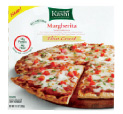
32 BEST PIZZA
Kashi Thin Crust Margherita
The pizza aisle is the nutrition badlands of the grocery store, but with a whole-wheat crust and veggie toppings, Kashi is giving other purveyors a hero to look up to. Per ⅓ pizza: 260 calories, 9 g fat, 29 g carbs, 4 g fiber

33 BEST FROZEN WAFFLE
Van’s 8 Whole Grains Multigrain Waffles
The bevy of grains in this waffle makes it a laudable stand-in for toast in your morning breakfast sandwich. Per 2 waffles: 180 calories, 7 g fat, 31 g carbs, 6 g fiber

34 BEST ICE CREAM
Breyers Natural Vanilla
With only five ingredients, it’s as unadulterated as you’ll get without churning it yourself. Per ½ cup: 130 calories, 7 g fat, 14 g carbs

35 BEST FROZEN TREAT
Klondike Slim a Bear No Sugar Added Vanilla Bars
Individual packaging acts as a built-in portion monitor—as long as you limit yourself to just one. Per bar: 170 calories, 9 g fat, 21 g carbs, 4 g fiber


36 BEST KETCHUP
Heinz Organic
Perfectly balanced. And researchers found that organic ketchup has close to double the lycopene of regular ketchups. Per Tbsp: 20 calories, 0 g fat, 5 g carbs

37 BEST MUSTARD
Inglehoffer Original Stone Ground Mustard
It’s grainy and robust, offering the double-punch of texture and flavor that can carry any dish to another level. Per tsp: 10 calories, 0 g fat, 1 g carbs

38 BEST MAYONNAISE
Kraft with Olive Oil Reduced Fat
Making mayo with olive oil instead of soybean oil displaces inferior omega-6 acids for heart-healthy monounsaturated fat. Per Tbsp: 45 calories, 4 g fat, 2 g carbs

39 BEST BBQ SAUCE
Dinosaur Bar-B-Que Roasted Garlic Honey
It expertly balances the sweetness with subtle notes of smoke and tang. Per 2 Tbsp: 25 calories, 0 g fat, 6 g carbs
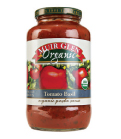
40 BEST PASTA SAUCE
Muir Glen Organic Tomato Basil
Organic tomatoes are one of the few fruits to be scientifically proven more nutritious than their conventional counterparts. Stock up. Per ½ cup: 60 calories, 1 g fat, 12 g carbs, 2 g fiber
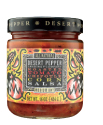
41 BEST SALSA
Desert Pepper Roasted Tomato Chipotle Corn
This jar has far more flavor than your standard Old El Paso. The chipotle gives it some smokey spice, while the corn lends a hint of sweetness. Per 2 Tbsp: 10 calories, 2 g carbs
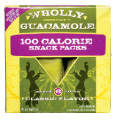
42 BEST PREMADE GUACAMOLE
Wholly Guacamole
Unlike many of its competitors, Wholly makes its guac with real avocadoes. Per 2 oz: 50 calories, 4 g fat, 2 g fiber, 190 mg sodium
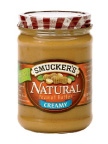
43 BEST PEANUT BUTTER
Smucker’s Natural Chunky
You’ll find no added oils, sweeteners, or fillers in this jar—just peanuts and salt. Sure you have to stir it, but that’s a small price to pay for real, unadulterated peanut butter. Per 2 Tbsp: 200 calories, 16 g fat, 90 mg sodium

44 BEST DIP
Guiltless Gourmet Mild Black Bean Dip
Functions great as a dip, but it also works as a flavorful spread for wraps and burritos. Per 2 Tbsp: 40 calories, 0 g fat, 2 g fiber, 125 mg sodium
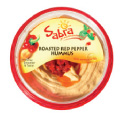
45 BEST HUMMUS
Sabra Roasted Red Pepper Hummus
Hummus is the most underutilized spread in your refrigerator. Try on deli sandwiches or alongside a piece of grilled meat or fish. Per 2 Tbsp: 70 calories, 6 g fat, 1 g fiber, 120 mg sodium

46 BEST SALAD DRESSING
Drew’s All Natural Smoked Tomato
The blend of sweetness and smokiness makes this great for a hearty salad, but maybe even better as an impromptu marinade. Try both and decide for yourself. Per Tbsp: 50 calories, 5 g fat, 69 mg sodium

47 RANCH REPLACEMENT
Annie’s Naturals Organic Buttermilk Dressing
Made with low-fat buttermilk and plenty of herbs and spices, this is a dead ringer for ranch, with nearly a third of the calories. Per 2 Tbsp: 60 calories, 6 g fat, 230 mg sodium
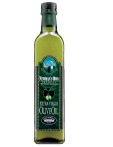
48 BEST EVERYDAY COOKING OIL
Newman’s Own Organic Extra Virgin Olive Oil
A nicely balanced oil that’s perfect for cooking or making homemade vinaigrettes. Per Tbsp: 130 calories, 14 g fat
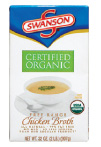
49 BEST COOKING BROTH
Swanson Certified Organic Free Range Chicken Broth
This has the best flavor of all the broths we tasted, and because it’s organic, you’ll have no trace antibiotics leaching into your family’s food. Per cup: 15 calories, 0.5 g fat, 550 mg sodium

50 BEST SOY SAUCE
Kikkoman Less Sodium
Sodium is the Achilles’ heal of soy sauce, but thankfully Kikkoman makes one that’s reasonable. Combine it with brown sugar, chopped scallions, minced ginger, and minced garlic for a good all-purpose marinade. Per Tbsp: 10 calories, 575 mg sodium
HOW WE CHOSE THE WINNERS: We created this list by first comparing the nutrition labels of competing brands in each of our 50 categories. We gave bonus points to products with more protein and fiber and less added sugar and sodium. We also took calories per serving into consideration. Once we pared down our choices, we matched them in head-to-head taste tests to determine the victors. As for draws, the nod went to the product with the fewest ingredients—which happens to be a good rule of thumb, period.